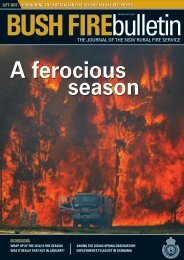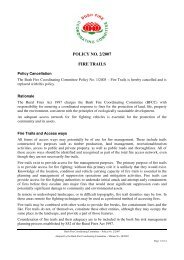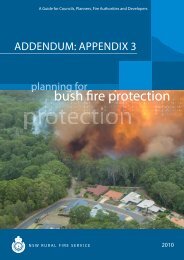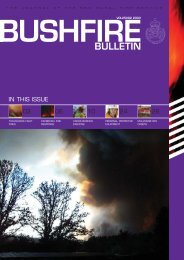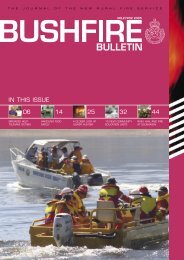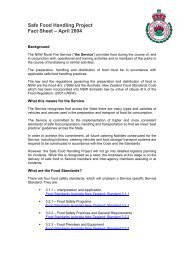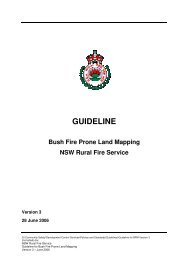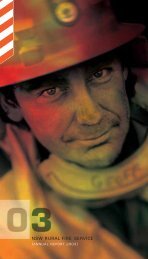Click here to view - NSW Rural Fire Service
Click here to view - NSW Rural Fire Service
Click here to view - NSW Rural Fire Service
Create successful ePaper yourself
Turn your PDF publications into a flip-book with our unique Google optimized e-Paper software.
Annex A <strong>to</strong><br />
Bush <strong>Fire</strong> Coordinating Committee<br />
Policy No. 1/2008<br />
Bush <strong>Fire</strong> Risk Management<br />
3.4 <strong>Fire</strong> Thresholds<br />
The vegetation in the Hunters Hill, Ryde, Lane Cove, Willoughby BFMC area was<br />
classified in<strong>to</strong> fire threshold categories (Table 3.3). Refer <strong>to</strong> for fire threshold<br />
mapping of the vegetation in the Hunters Hill, Ryde, Lane Cove, Willoughby BFMC area.<br />
<br />
<br />
Vegetation formation<br />
Minimum<br />
SFAZ<br />
Threshold<br />
Minimum<br />
LMZ<br />
Threshold<br />
Maximum<br />
Threshold<br />
Notes<br />
Rainforest NA NA NA <strong>Fire</strong> should be avoided.<br />
Alpine complex NA NA NA <strong>Fire</strong> should be avoided.<br />
Wet Sclerophyll forest<br />
(shrubby subformation)<br />
Wet Sclerophyll forest<br />
(grassy subformation)<br />
25 30 60<br />
10 15 50<br />
Grassy woodland 5 8 40<br />
Grassland 2 3 10<br />
Dry sclerophyll forest<br />
(shrub/grass subformation)<br />
Dry sclerophyll forest<br />
(shrub subformation)<br />
5 8 50<br />
7 10 30<br />
Heathlands 7 10 30<br />
Freshwater wetlands 6 10 35<br />
Forested wetlands 7 10 35<br />
Crown fires should be avoided in the<br />
lower end of the interval range.<br />
Crown fires should be avoided in the<br />
lower end of the interval range.<br />
Minimum interval of 10 years should<br />
apply in the southern Tablelands area.<br />
Occasional intervals greater then 15<br />
years may be desirable.<br />
Occasional intervals greater than 7<br />
years should be included in coastal<br />
areas. T<strong>here</strong> was insufficient data <strong>to</strong><br />
give a maximum interval; available<br />
evidence indicates maximum intervals<br />
should be approximately 10 years.<br />
Occasional intervals greater than 25<br />
years may be desirable.<br />
Occasional intervals greater than 25<br />
years may be desirable.<br />
Occasional intervals greater than 20<br />
years may be desirable.<br />
Occasional intervals greater than 30<br />
years may be desirable.<br />
Some intervals greater than 20 years<br />
may be desirable.<br />
Saline wetlands NA NA NA <strong>Fire</strong> should be avoided.<br />
Semi-arid woodlands<br />
(grassy subformation)<br />
Semi-arid woodlands<br />
(shrubby subformation)<br />
Arid shrublands (chenopod<br />
subformation<br />
Arid shrublands (acacia<br />
subformation)<br />
6 9 No max<br />
10 15 No Max<br />
Not enough data for a maximum fire<br />
interval.<br />
Not enough data for a maximum fire<br />
interval.<br />
NA NA NA <strong>Fire</strong> should be avoided.<br />
10 15 No Max<br />
Not enough data for a maximum fire<br />
interval.<br />
<br />
Bush <strong>Fire</strong> Coordinating Committee – Policy No 1/2008<br />
Adopted by the Bush <strong>Fire</strong> Coordinating Committee - Minute No. 24/2008



